- Home
- Garden Wildlife
- Molluscs
- Terrestrial snails
Terrestrial snails
Generally the gastropods - slugs and snails - are among the more disliked invertebrates in gardens, but snails, with their attractive shells are probably seen as marginally nicer than slugs. This page deals with land snails, but there are a number of freshwater species we cover in our page here.
Species in Britain and Ireland
There are 99 species of land snails in Britain and Ireland from about 27 families, and some are common in gardens. Nearly all our land snails (and slugs) are "pulmonates" or snails with an air-breathing lung instead of the gills typical of most gastropods that live in the sea or fresh water. Jennifer Owen found 8 species in her garden.
There are just two non-pulmonate land snails in Britain. Both are uncommon, and only one Pomatius elegans might possibly turn up in a chalky-rocky garden, and it can be easily recognised because it has a hard chalky operculum on its "back" that is used to block up the opening of the shell like a trapdoor. The true operculum is absent in pulmonate snails.
The pulmonate land snails could be unscientifically divided into three broad groups depending on the shape of their shells.
Snails with shells taller than their width
A large number of British land snail species would fall into this category. Most are very small, and some rare and confined to special habitats. Others, such as the 5-7mm slippery moss snail Cochlicopa lubrica are quite common, but favour moist shaded habitats. The chrysalis snail Lauria cylindracea is very small at 2-4mm long and easily missed. It is more tolerant of drier places such as under ivy, and has a tiny tooth in the shell opening. These teeth or "denticles" are quite common in land snails and are thought to restrict the opening of the shell to predators. The two-toothed door snail Clausilia bidentata is one of eight British and Irish species of "door snails" so called because they make an operculum-like structure that blocks the entrance to the shell when the snail is withdrawn, defeating attacking beetles. It is very long for its width. It lives in leaf litter and emerges on a damp day or at night, climbing to browse on algae and lichens
Snails with shells that are about as wide as high
This final group contains some of the most familiar larger garden snails of which the common garden snail, Cornu aspersum, is the best known. It was until recently called Helix aspersa, in the same genus as the larger edible or Roman snail Helix pomatia which isn't a common garden species. Remarkably both species are introductions by the Romans, who brought them over from North Africa to rear as food animals - a practice called heliciculture. Given the damage the common garden snail can wreak on young plants, we would encourage you all to collect and cook them rather than scattering slug-pellets everywhere. Cornu aspersum has gone on to conquer most of the world, they are now found on all continents except Antarctica.
Girdled snail Hygromia cinctella Kentish garden snail Monacha cantiana
Biology
Read about the general biology of gastropods in our introductory page here. Snails produce a hard shell that encloses part of their body and into which the entire body can usually be withdrawn when danger or adverse conditions occur. Because of this, land snails can tolerate drier conditions than slugs, but are still more active after dark. They secrete a thin slimy mucus from their bodies, which helps to facilitate their movement, but can also secrete a more viscous form to help them stick to surfaces, especially when preparing to aestivate (inactive phase in a dry summer akin to hibernation in winter).
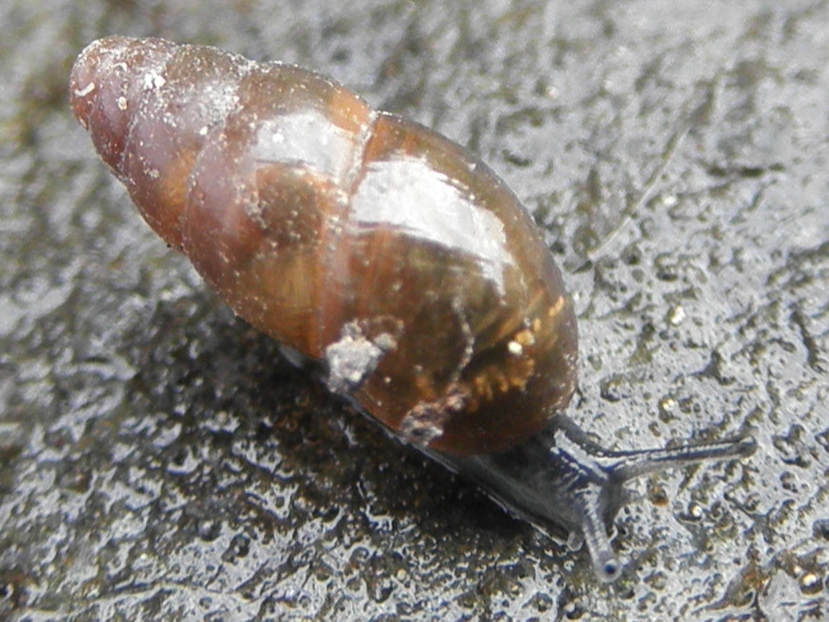
Left: Slippery moss snail Cochlicopa lubrica, Centre: empty shell of chrysalis snail Lauria cylindracea showing denticle, Right: door snail Clausilia bidentata
Snails with shells wider than they are high
Many garden snails have flattened shells that are clearly wider than their height. The 5-7mm discus snail Discus rotundatus is widespread and common in any sort of sheltered garden site while the slightly larger strawberry snail Trochulus striolatus prefers low moist vegetation, and does indeed like strawberry plants and lettuce, and can be a nuisance. The closely related hairy snail is widespread and common and has "hairs" on its shell surface. These often rub off, but can usually be seen round the shell opening. The vallonia snail Vallonia costata is much smaller, less than 3mm wide and one of the species recorded by Jennifer Owen. It favours drier habitats like walls and rocks,and the species name costata refers to its ribbed patterning. The milky crystal snail Vitrea contracta was also found by Owen and is equally small, with a glassy,semi-transparent shell.
.jpeg)
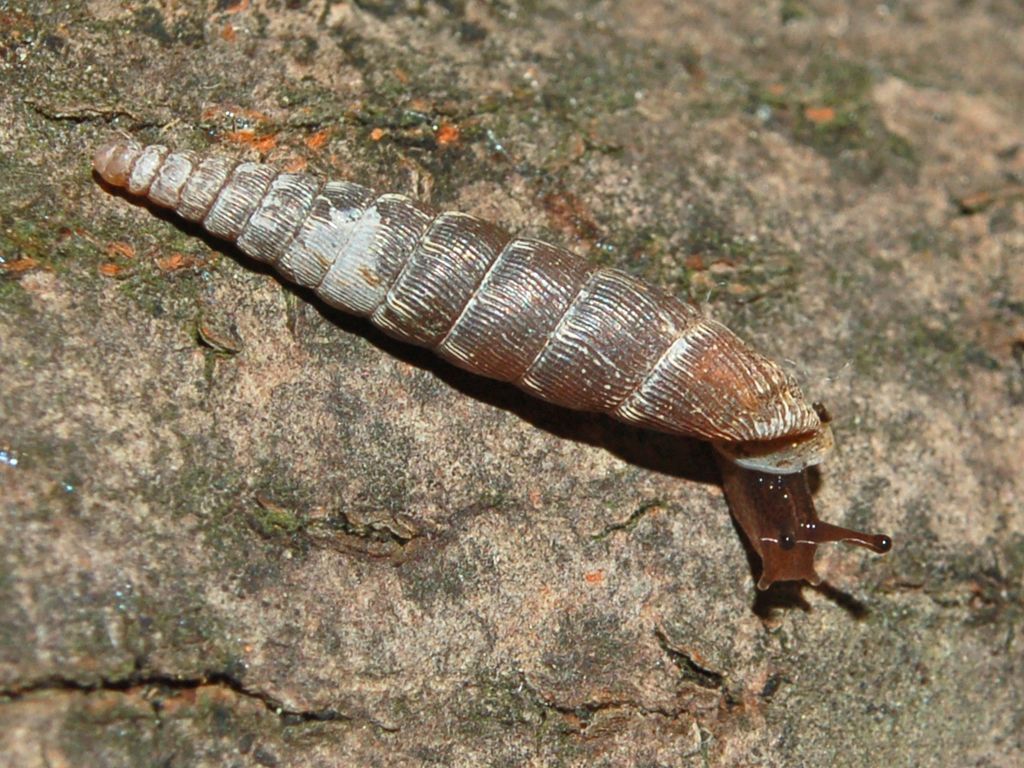
The family Oxychilidae includes several larger garden species, some with glassy shells. These include the 10mm smooth glass snail Aegopinella nitidula, Draparnaud's glass snail Oxychilus draparnaudi up to 15mm and the 6-8mm Oxychilus alliarius, commonly known as the garlic snail or garlic glass-snail. All these were found by Jennifer Owen, and the garlic snail really does smell strongly of garlic. The related cellar snail Oxychilus cellarius also smells of garlic, but faintly, and is found in shady moist places, not just in cellars. Finally, the lapidary snail Helicigona lapicida is 20mm wide and very lens-shaped with a sharp keel around the edge of the shell. It likes shady walls with ivy, and crevices in tree trunks.
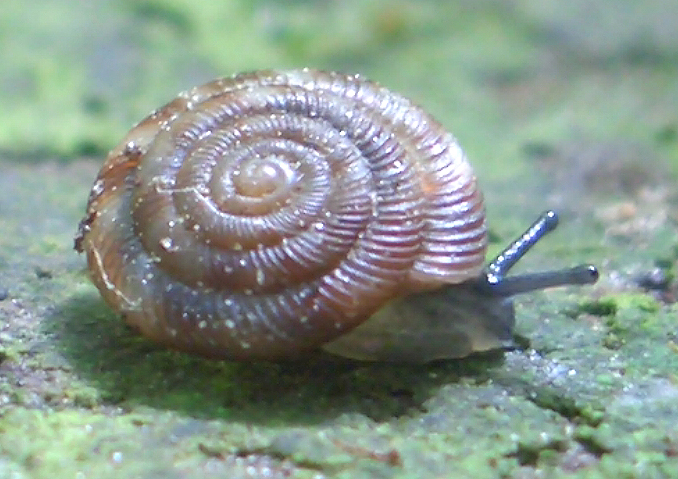
.jpg)
.jpg)
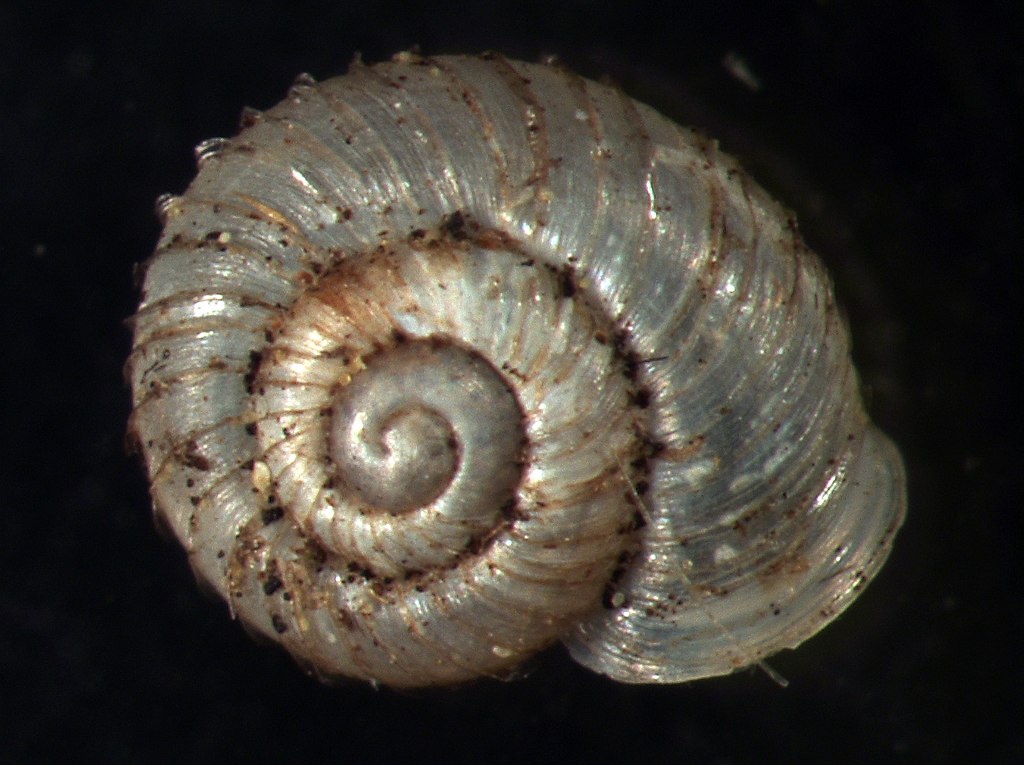
.jpeg)
Top. Left: discus snail Discus rotundatus, Centre: strawberry snail Trochulus striolatus Right: Hairy snail Trochulus hispidus.
Left: Far left: Vallonia snail Vallonia costata Left: Milky crystal snail Vitrea contracta
.jpg)
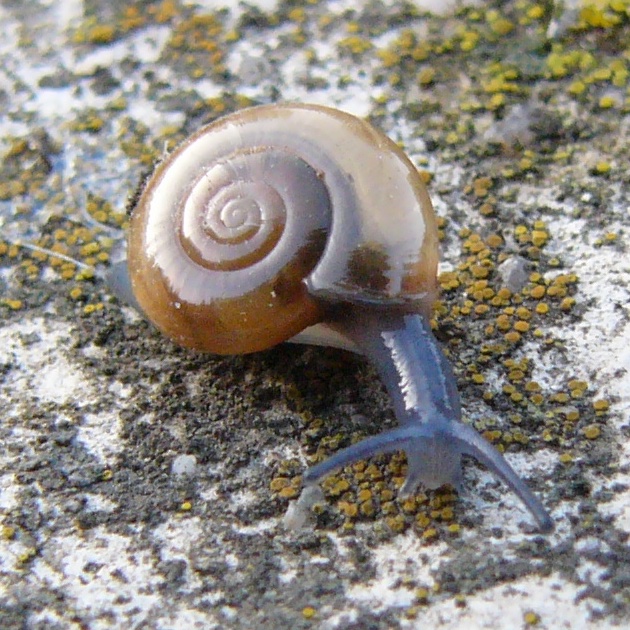
.jpg)
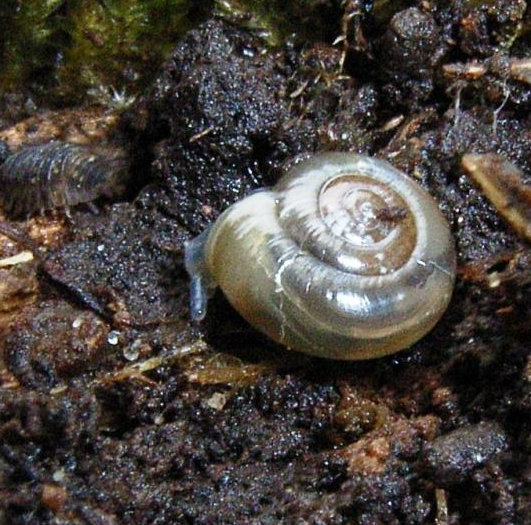
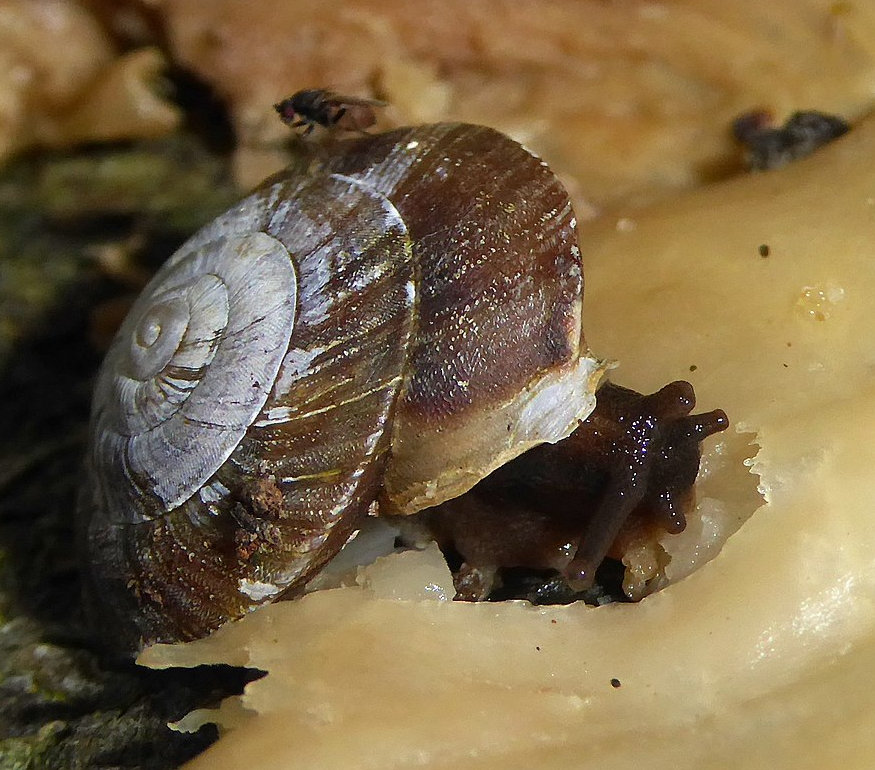
Above: Left: Smooth glass snail Aegopinella nitidula Centre: Draparnaud's glass snail Oxychilus draparnaudi Right: Garlic snail Oxychilus alliarius
Left: Far left: Cellar snail Oxychilus cellarius Left: Lapidary snail Helicigona lapicida
Every gardener's favourite, the common garden snail, Cornu aspersum
The next most common snails seen are the native banded or humbug snails, the brown-lipped banded snail, Cepaea nemoralis, and the white-lipped banded snail, Cepaea hortensis. Both have yellow and brown banded shells but are very variable in colour, with some forms being entirely yellow or pinkish brown. They can be distinguished (usually) by the colour of shell rim around the opening. Cepaea nemoralis has for decades been a favourite organism used in the study of polymorphism. The banded snails are enthusiastically predated by thrushes, and the different colour patterns each confer some camouflage within different habitats.
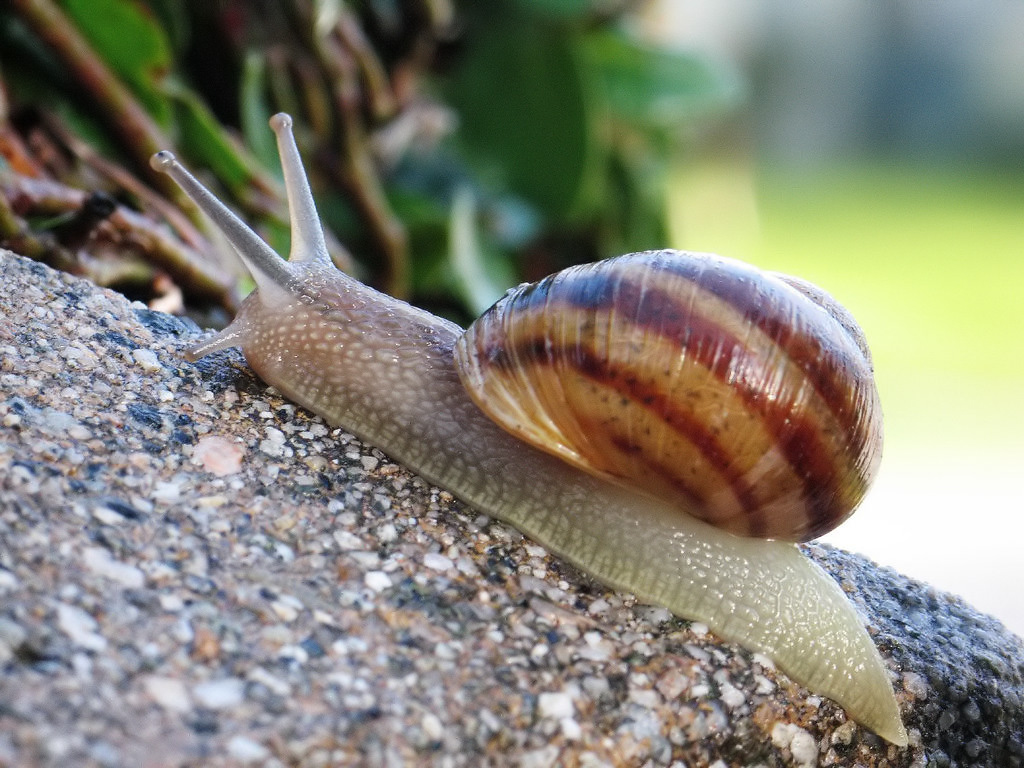

Two other snails with this shape have been recently introduced. The 10mm Hygromia cinctella, known commonly as the girdled snail has been here since the 1950's. Originally from the Mediterranean it is now as far north as Scotland. Monacha cantiana, the Kentish garden snail, is now quite common in England, growing to 16mm.
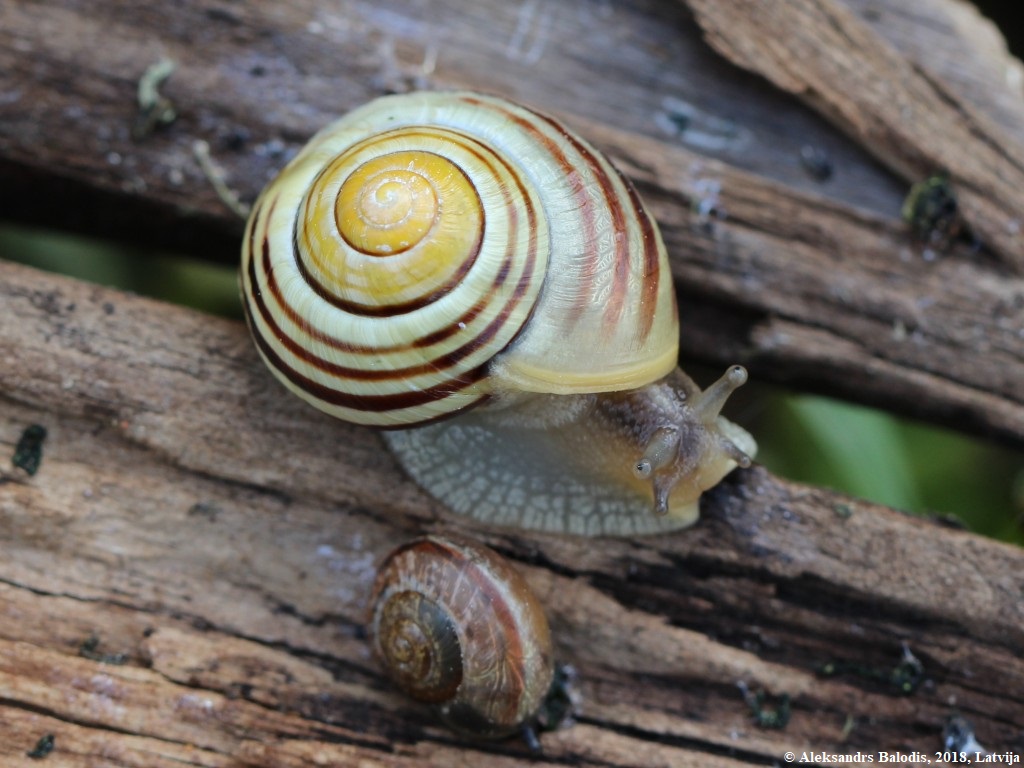
Above: Strikingly different colour and banding forms of the brown-lipped banded snail, Cepaea nemoralis.
Left: white-lipped banded snail, Cepaea hortensis showing the pale lip compared with the brown lip on the snails above. There is a young Cornu aspersum below it.
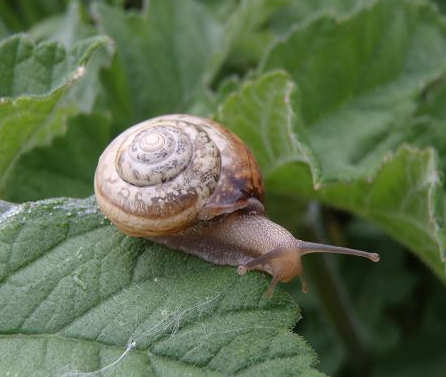
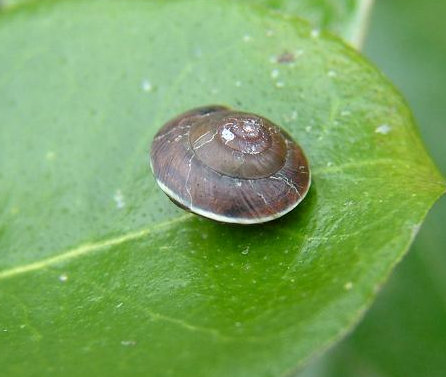
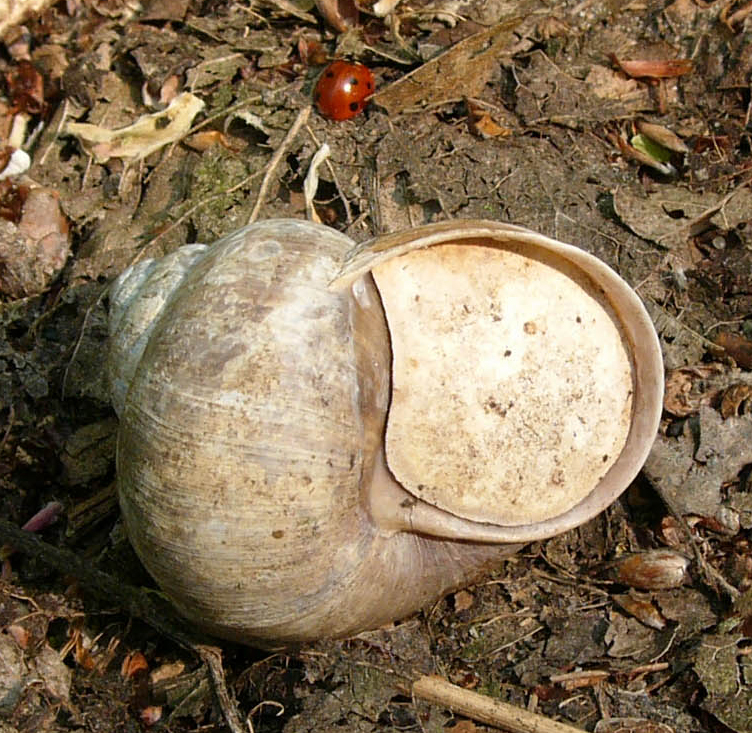
Role of slugs and snails in gardens
The only significant pest snail in the garden is Cornu aspersum, the common garden snail. Seedlings and very young plants are particularly at risk, and when they are strong enough to plant out they are at lower risk. There are many suggested snail repellents, but while some like eggshells or wool may work for a while, they cease to be effective after rain. Copper bands do seem to work, but cease to be so effective as they corrode. We do not recommend using slug pellets in the open garden, but there is every reason to use them in closed greenhouses or cold frames. Banded snails seem to cause little damage as they feed mainly on dead plant material and algae on plant stems. The other snails found in gardens are small and generally have little impact on plants.
Snails and their eggs are eaten by a wide range of invertebrates, especially fly larvae (including parasitoids as well as predators)and beetles including the glow-worm beetle Lampyris noctiluca. Snails are part of the diet of hedgehogs, shrews, amphibians and some birds. The song thrush will take large numbers of snails, particularly when there are fledgling birds to feed. Thrushes use a stone or other hard object as an anvil. They bang the snail against a stone until the shell is broken and the snail’s body can be extracted.
In autumn, snails seek out sheltered places and close up the entrance to their shells with a thin dried-mucus and chalk plug called an epiphragm. This dries up and seals the snail within its shell. They remain dormant until warmer weather in spring makes them active again.
Left: Epiphragm of Helix pomatia, the edible or Roman snail
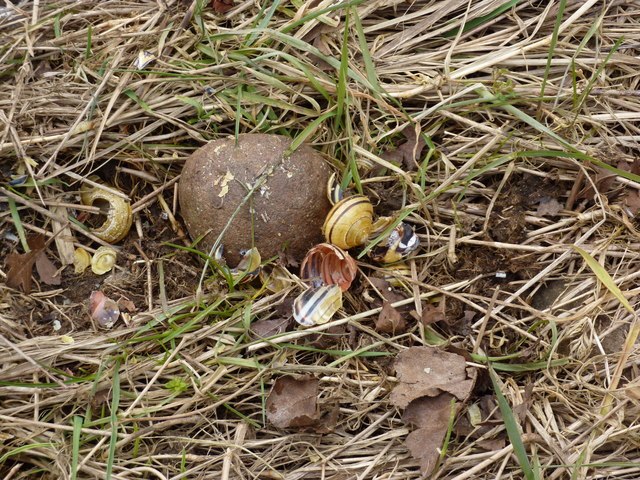
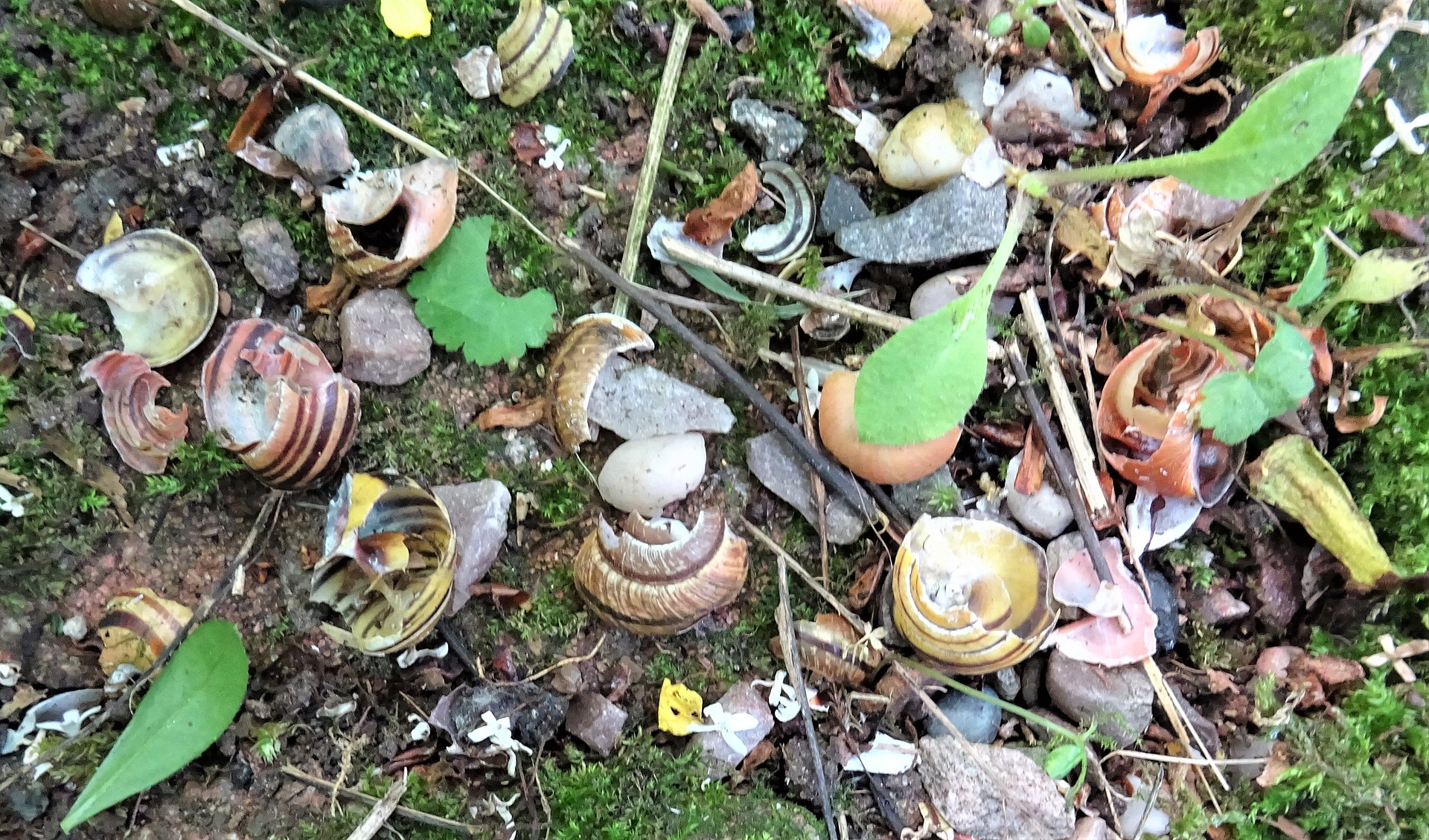
Song thrush anvil stone and the remains of a number of snails, mostly Cepaea species.
Other sources of information
Website
Website of the Conchological Society of Great Britain and Ireland
Brian Eversham's page on identifying land snails on NatureSpot
Books
Barker, G.M. (ed) (2001) The Biology of Terrestrial Molluscs CABI Publishing
Cameron, R. (2016) Slugs and Snails. New Naturalist Series Harper Collins London
Cameron, R. & Riley, G. (2008) Land snails in the British Isles. A Field Studies Council AIDGAP key
Kerney, M. & Cameron, R. A. D. (1979) A Field Guide to the Land Snails of Britain and North-west Europe. Harper Collins
Page drafted by Andrew Halstead, reviewed by Andrew Salisbury, extended and compiled by Steve Head
Terrestrial snails
Generally the gastropods - slugs and snails - are among the more disliked invertebrates in gardens, but snails, with their attractive shells are probably seen as marginally nicer than slugs. This page deals with land snails, but there are a number of freshwater species we cover in our page here.
Species in Britain and Ireland
There are 99 species of land snails in Britain and Ireland from about 27 families, and some are common in gardens. Nearly all our land snails (and slugs) are "pulmonates" or snails with an air-breathing lung instead of the gills typical of most gastropods that live in the sea or fresh water. Jennifer Owen found 8 species in her garden.
There are just two non-pulmonate land snails in Britain. Both are uncommon, and only one Pomatius elegans might possibly turn up in a chalky-rocky garden, and it can be easily recognised because it has a hard chalky operculum on its "back" that is used to block up the opening of the shell like a trapdoor. The true operculum is absent in pulmonate snails.
The pulmonate land snails could be unscientifically divided into three broad groups depending on the shape of their shells.
Snails with shells taller than their width
A large number of British land snail species would fall into this category. Most are very small, and some rare and confined to special habitats. Others, such as the 5-7mm slippery moss snail Cochlicopa lubrica are quite common, but favour moist shaded habitats. The chrysalis snail Lauria cylindracea is very small at 2-4mm long and easily missed. It is more tolerant of drier places such as under ivy, and has a tiny tooth in the shell opening. These teeth or "denticles" are quite common in land snails and are thought to restrict the opening of the shell to predators. The two-toothed door snail Clausilia bidentata is one of eight British and Irish species of "door snails" so called because they make an operculum-like structure that blocks the entrance to the shell when the snail is withdrawn, defeating attacking beetles. It is very long for its width. It lives in leaf litter and emerges on a damp day or at night, climbing to browse on algae and lichens

.jpeg)

Snails with shells wider than they are high
Many garden snails have flattened shells that are clearly wider than their height. The 5-7mm discus snail Discus rotundatus is widespread and common in any sort of sheltered garden site while the slightly larger strawberry snail Trochulus striolatus prefers low moist vegetation, and does indeed like strawberry plants and lettuce, and can be a nuisance. The closely related hairy snail is widespread and common and has "hairs" on its shell surface. These often rub off, but can usually be seen round the shell opening. The vallonia snail Vallonia costata is much smaller, less than 3mm wide and one of the species recorded by Jennifer Owen. It favours drier habitats like walls and rocks,and the species name costata refers to its ribbed patterning. The milky crystal snail Vitrea contracta was also found by Owen and is equally small, with a glassy,semi-transparent shell.
Above: Left: Slippery moss snail Cochlicopa lubrica, Right: empty shell of chrysalis snail Lauria cylindracea showing denticle,
Left: door snail Clausilia bidentata

.jpg)
.jpg)

.jpeg)
Above. Left: discus snail Discus rotundatus, Right: strawberry snail Trochulus striolatus
Left: Hairy snail Trochulus hispidus.
Below. Left: Vallonia snail Vallonia costata Right Milky crystal snail Vitrea contracta
The family Oxychilidae includes several larger garden species, some with glassy shells. These include the 10mm smooth glass snail Aegopinella nitidula, Draparnaud's glass snail Oxychilus draparnaudi up to 15mm and the 6-8mm Oxychilus alliarius, commonly known as the garlic snail or garlic glass-snail. All these were found by Jennifer Owen, and the garlic snail really does smell strongly of garlic. The related cellar snail Oxychilus cellarius also smells of garlic, but faintly, and is found in shady moist places, not just in cellars. Finally, the lapidary snail Helicigona lapicida is 20mm wide and very lens-shaped with a sharp keel around the edge of the shell. It likes shady walls with ivy, and crevices in tree trunks.
.jpg)

.jpg)


Above: Left: Smooth glass snail Aegopinella nitidula Right: Draparnaud's glass snail Oxychilus draparnaudi
Left: Garlic snail Oxychilus alliarius
Below: Left: Cellar snail Oxychilus cellarius Right: Lapidary snail Helicigona lapicida

Snails with shells that are about as wide as high
This final group contains some of the most familiar larger garden snails of which the common garden snail, Cornu aspersum, is the best known. It was until recently called Helix aspersa, in the same genus as the larger edible or Roman snail Helix pomatia which isn't a common garden species. Remarkably both species are introductions by the Romans, who brought them over from North Africa to rear as food animals - a practice called heliciculture. Given the damage the common garden snail can wreak on young plants, we would encourage you all to collect and cook them rather than scattering slug-pellets everywhere. Cornu aspersum has gone on to conquer most of the world, they are now found on all continents except Antarctica.
Every gardener's favourite, the common garden snail, Cornu aspersum
The next most common snails seen are the native banded or humbug snails, the brown-lipped banded snail, Cepaea nemoralis, and the white-lipped banded snail, Cepaea hortensis. Both have yellow and brown banded shells but are very variable in colour, with some forms being entirely yellow or pinkish brown. They can be distinguished (usually) by the colour of shell rim around the opening. Cepaea nemoralis has for decades been a favourite organism used in the study of polymorphism. The banded snails are enthusiastically predated by thrushes, and the different colour patterns each confer some camouflage within different habitats.

Above: Strikingly different colour and banding forms of the brown-lipped banded snail, Cepaea nemoralis.
Below: white-lipped banded snail, Cepaea hortensis showing the pale lip compared with the brown lip on the snails above. There is a young Cornu aspersum below it.

Girdled snail Hygromia cinctella Kentish garden snail Monacha cantiana
Biology
Read about the general biology of gastropopds in our introductory page here. Snails produce a hard shell that encloses part of their body and into which the entire body can usually be withdrawn when danger or adverse conditions occur. Because of this, land snails can tolerate drier conditions than slugs, but are still more active after dark. They secrete a thin slimy mucus from their bodies, which helps to facilitate their movement, but can also secrete a more viscous form to help them stick to surfaces, especially when preparing to aestivate (inactive phase in a dry summer akin to hibernation in winter).

Two other snails with this shape have been recently introduced. The 10mm Hygromia cinctella, known commonly as the girdled snail has been here since the 1950's. Originally from the Mediterranean it is now as far north as Scotland. Monacha cantiana, the Kentish garden snail, is now quite common in England, growing to 16mm.

In autumn, snails seek out sheltered places and close up the entrance to their shells with a thin dried-mucus and chalk plug called an epiphragm. This dries up and seals the snail within its shell. They remain dormant until warmer weather in spring makes them active again.
Left: Epiphragm of Helix pomatia, the edible or Roman snail
Role of slugs and snails in gardens
The only significant pest snail in the garden is Cornu aspersum, the common garden snail. Seedlings and very young plants are particularly at risk, and when they are strong enough to plant out they are at lower risk. There are many suggested snail repellents, but while some like eggshells or wool may work for a while, they cease to be effective after rain. Copper bands do seem to work, but cease to be so effective as they corrode. We do not recommend using slug pellets in the open garden, but there is every reason to use them in closed greenhouses or cold frames. Banded snails seem to cause little damage as they feed mainly on dead plant material and algae on plant stems. The other snails found in gardens are small and generally have little impact on plants.
Snails and their eggs are eaten by a wide range of invertebrates, especially fly larvae (including parasitoids as well as predators)and beetles including the glow-worm beetle Lampyris noctiluca. Snails are part of the diet of hedgehogs, shrews, amphibians and some birds. The song thrush will take large numbers of snails, particularly when there are fledgling birds to feed. Thrushes use a stone or other hard object as an anvil. They bang the snail against a stone until the shell is broken and the snail’s body can be extracted.

Song thrush anvil stone and the remains of a number of snails, mostly Cepaea species.
Other sources of information
Website
Brian Eversham's page on identifying land snails on NatureSpot
Books
Barker, G.M. (ed) (2001) The Biology of Terrestrial Molluscs CABI Publishing
Cameron, R. (2016) Slugs and Snails. New Naturalist Series Harper Collins London
Cameron, R. & Riley, G. (2008) Land snails in the British Isles. A Field Studies Council AIDGAP key
Kerney, M. & Cameron, R. A. D. (1979) A Field Guide to the Land Snails of Britain and North-west Europe. Harper Collins
Page drafted by Andrew Halstead, reviewed by Andrew Salisbury, extended and compiled by Steve Head














